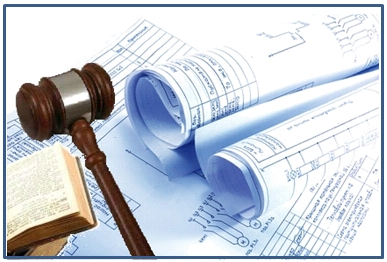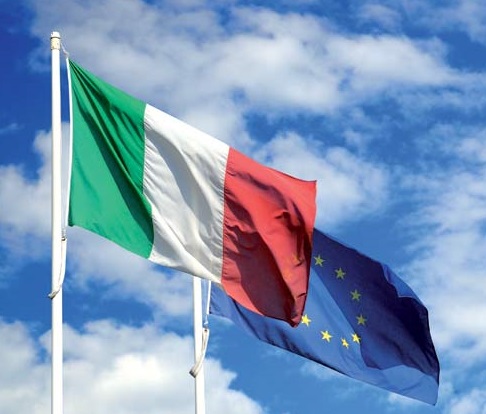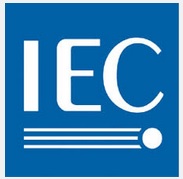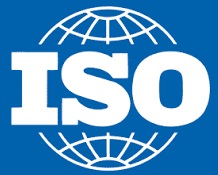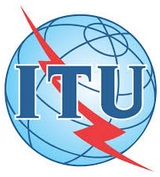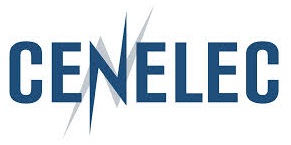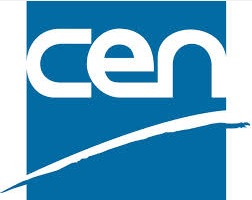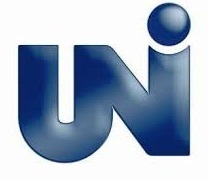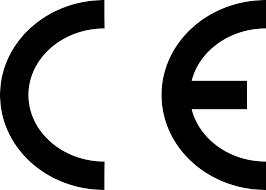Introduction
The purpose of this article is to provide a short and practical manual regarding the vast and complex field of technical standards in electrical engineering and electronics. In particular I will talk about the rules adopted by qualified bodies and recognized nationally and internationally and produced by the contribution, the consent and approval of all parties involved such as designers, installers, manufacturers, consumer groups, the competent authorities. All these standards, thanks to their universality, represent a valuable tool for civil progress.
In fact, the correct application of technical standards, in addition to ensuring an acceptable level of safety, is essential for the improvement of methods of design, production processes control and testing. All this leads to a significant improvement of the final product and therefore to the protection of consumer interests.
In reference to standardization, the UNI CEI EN 45020 “Standardization and related activities – General vocabulary” entered into force on 27 July 2007 provides the following definitions:
- Standard: «document, established by consensus and approved by a recognized organization, that provides, for common and repeated use, rules, guidelines or features, relating to certain activities or their results, in order to get the best order in a given context . »
- Standard Organization «Organization with standardization activities, nationally recognized, regional or international, whose main function, in terms of their statutes, is the elaboration, approval or adoption of standards that are made available to the public.»
- State of the art «Stage of development reached at a given time by the technical capabilities relating to products, processes or services based on scientific, technological and experimental results.»
About the characteristics of a standard, the UNI CEI EN 45020 clarifies that a standard must necessarily be based on proven scientific, technological and experimental results aimed at achieving the best benefits for the community.
In Italy a definition of standard is also given by Law 317 of 21/06/1986 preliminary definitions d): “standard: a technical specification approved by a recognized organization, This is authorized to issue standardization acts, compliance with which is not compulsory, and belonging to one of the following categories: international standards, European standards, national standards. The adopted standards are international, European or national standards, and they are made available to the public by an international organization, respectively, by a European or by a national organization of standardization.”
In practice, a technical standard published by a recognized standards body, is a document that establishes and defines the basic requirements of performance, size, safety, environmental, that the equipment or component must possess, This is ensured so that their compliance with the “state of the art”. Consequently its legal value is such that its application, although not mandatory, ensures compliance to the rule of art sanctioned by several Italian laws.
The standards are divided into two categories:
- legal standards or laws are those that establish the rules of conduct for all individuals under the sovereignty of a State. They dictate the conduct in general without entering any way in the detail of the technical requirements for which refer to specific technical standards. They are mandatory and may be issued by the national legislative bodies. In this case, they are the ordinary laws issued by the Parliament, the decree-laws issued by the Government, the decrees of the President of the Republic, or by the bodies of Community legislation in this case Directives, Regulations, Decisions;
- technical regulations or standards are technical documents obtained through the application of the fundamental principle of “consensus”, ie their formulation and subsequent implementation are based on availability and the free adherence of all stakeholders, from design to manufacturing to marketing. They describe and codify the best available technology and define terminology, measurements and measurement methods, conventional symbology, security guarantees, performance requirements, type, compatibility, design activities, with regard to the materials, products, equipment, methods, services. Technical standards are issued only by bodies recognized by specific laws. They are not mandatory but become so in the event that is expressly referred to one of them within a rule of law.
Standardization bodies
The function of standardization bodies is to draft technical standards in order to achieve maximum efficiency and the highest level of product safety, machinery, people and facilities. Typically, they consist of specific “Technical Committees” and “Technical Subcommittees” whose job is to prepare and publish the general and special rules regarding the design, implementation, testing and maintenance of equipment, materials and machinery. Standards organizations should be recognized with appropriate legal standards. They may issue regulatory technical documents worldwide, European and national. Currently they are grouped into three main areas (see Fig.1).
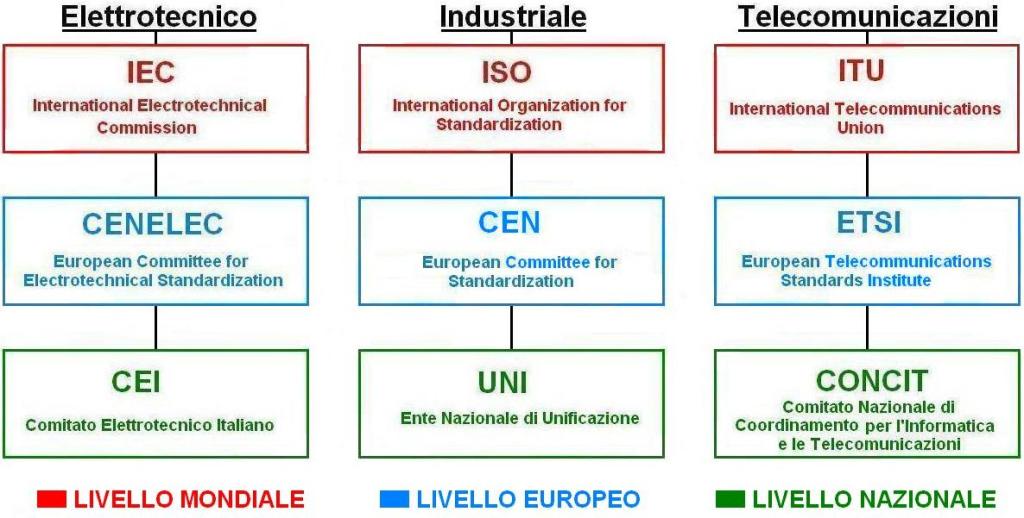
Here is a list of worldwide recognized regulatory bodies:
- IEC (International Electrotechnical Commission – Commission Electrotechnique Internationaleé) is an organization founded in 1906 with headquarters in Geneva. It prepares and publishes technical standards in electrical engineering and electronics with the participation of standards bodies from more than 100 nations around the world divided into about 90 Technical Committees, 120 technical subcommittees.
The Technical Committees are divided into three groups:
- Group A plays standardizing body for electrical engineering and general problems;
- Group B carries out legislation for the electronics and computer science;
- Group C carries out legislation for the measures, safety and consumer goods.
The publications of this organism are issued in two official languages, English and French. They are not binding and can be implemented by European bodies such as the harmonized standards or by national agencies adapting to the rules that already exist with or without modifications. They are classified by the acronym IEC followed by a number. Some examples are the norm IEC 1168 relative to radiotherapy simulators or IEC 60364 for electrical installations of buildings. In 1991, the IEC has entered into a collaboration agreement with the CENELEC to study the issue and voting common normative documents.
ISO (International Organization for Standardization – Organisation Internationaleé de Normalisation) founded in 1947, is based in Geneva and is the most important institution for the development and publication of international standards. It plays worldwide standardization activities in various industries, especially in mechanical and quality with the exclusion of the electrical engineering and electronics.
Actually the term ISO is not to be considered as an acronym. In fact, it comes from the greek “isos” meaning equal. Its members are the standards bodies of more than 160 countries of the world and its structure is composed of a series of technical committees ( TC ), subcommittee ( SC ) and working groups ( WG ) . The norms issued have value of recommendation and can be implemented by the various national bodies with or without modifications. They are classified by the ISO abbreviation followed by the number of the ISO standard, the symbol and the year of publication, such as ISO 9001: 2001.
ITU (International Telecommunications Union – Union Internationale des Télécommunications) is an organization that carries out standards for information technology and communication. It was founded in 1865 as the Telegraph Union, and in 1932 it took its present name of ITU headquartered in Geneva. Since 1947 is formed by the union of the CCITT (Consultative Committee for International Telegraphy and Telephony) and the CCIR (International Consultative Committee for Radiocommunications) becoming a specialized agency of the United Nations with the task of promoting the spread of telecommunications in developing countries and standardization of radio frequency spectrum around the world to ensure the exchange of information without interference.
Since 1992, this organization is divided into three areas of expertise:
- Radio Communications
- Telecommunications Development
- Telecommunication Standardization
They are classified by the initials ITU followed by a capital letter and a sequential number, for example ITU X.500 is a set of standards for computer networks, or ITU X.1211 of September 2014 concerning techniques to prevent attacks based on the web.
Here are the regulatory bodies recognized at European level:
CENELEC (European Committee for Electrotechnical Standardization – Comité Européen de Normalisation Electrotechnique) is the standards body for the electrotechnical industry and electronics including access control and video surveillance. It includes all European Union countries plus some non-EU members, such as Turkey, Ukraine, Belarus, Ia Tunisia, Israel. It was established in 1973 following the merger of two previous standards bodies: the CENELCOM and Cenel. Headquartered in Brussels, since 1991 it has established close cooperation with the IEC which can incorporate any regulations with or without modification. It was recognized as a standards body with the Directive 83/189 / EEC of 28/03/1983 and may issuethe following types of normative documents in the three official languages (English, German and French):
- EN (European Norm) are technical standards that must be implemented in full by all member states without any addition and / or modification and at the same time all the national standards that address the same issue must be collected (under the agreement stand-still Agreement which prohibits the publication of rules with content in contrast with the European Standards and obliges the withdrawal of those provisions on the same subject). In Italy the EN standards are implemented and published by Decree of the Ministry of Industry;
- HD (Harmonization Document) are reference standards that do not impose any obligation to full application except that the technical content. For example sentences can be modified to meet specific national requirements. Basically it is a legal document that must be implemented through national standards within a time agreed in advance. Harmonised standards provide a presumption of conformity with the essential safety requirements;
- EPS (European Norm vorübergehend) are experimental standards that have limited duration during which Member States may submit their proposals for changes;
- ES (European Specification), R (Relations), G (Guide), documents for information without obligation of transposition by the Member States.
CEN (European Committee for Standardization – Eurpéen Comité de Normalisation) is the standards body for all industries including construction and fire prevention with the exception of the electrical industry and electronics.It was founded in 1961 with headquarters in Brussels and works closely with the ISO. CEN members are the national bodies of the European Union together with the associate members such as FIEC (European Construction Industry Federation), ECOS (European Environmental Citizens Organisation for Standardisation), ETUI (European Trade Union Institute), EUCOMED (European Medical Technology Industry Association), ANEC (European Association for the coordination of consumer representation in Standardisation), CEFIC (European Chemical Industry Council). CEN has been recognized as a European standardization body with Directive 83/189 / EEC of 28/03/1983.
ETSI (European Telecommunications Standards Institute – Institut européen des normes de télécommunication) is an organism of standardization independent founded in 1988 by the CEPT (European Conference of Postal and Telecommunications), which was the coordinating body for European telecommunications organizations post since 1959. ETSI currently includes around 800 organizations representing 65 worldwide countries and has been recognized as a European standardization body with Directive 83/189 / EEC of 28/03/1983. ETSI standards are classified with the initials ES followed by a number. Some examples are the ETSI ES 201970-2 related to Access and Terminals (AT), public switched telephone network (PSTN) or ETSI ES 202 007 relating to electromagnetic compatibility and Radio spectrum Matters (ERM).
Here are nationally recognized regulatory bodies:
CEI Italian Electrotechnical Committee is the body of Italian Electrotechnical Standardization, electronics and some areas of telecommunications recognized with the Ministerial Decree of 15/12/1978 “Designation of the Italian Electrotechnical Committee which standards body electrical and electronics”
HERE you can see a list of regulatory bodies of other nations. It was founded in 1909, headquartered in Milan and is accredited as a representative of the Italian State at CENELEC and IEC. Through its participation in the CIT, it participates in the work of ETSI European standards body for telecommunications.
The CEI is composed of:
- Promoting members: ANIE (National Association of Electrical and Electronic Industries), ENEL (National Agency for Electricity), AEIT (Italian Association of Electrical, Electronics, Automation, Information and Communication Technology;
- Members of law: CNR (National Research Council), Ministry of Interior, Ministry of Economic Development, Ministry of Education, University and Research, Ministry of Infrastructure and Transport, Ministry of Defense, Ministry of Health, Ministry of Heritage and Culture and Tourism, Ministry of Labour and Social Policy, Ministry of the Environment;
- Active Members: electrotechnical and electronics companies, various associations of enterprises;
- Associate Members: various companies and individuals who are not entitled to participate in the Technical Committees and the shareholders meeting.
Currently the CEI is structured over 85 Technical Committees (CT), which are further divided into sub-committees (SC) each with expertise in a particular technical field. Both CT and SC can consist of by temporary working groups (WG), particularly for the drafting of national documents. All information and a full list of the Technical Committees of the IEC is available HERE.
In 1947 the CEI in association with the ANIE (National Association of Electrotechnical Industries) and ANIDEL (National Association of Electricity Producers) has been the UNEL (Electrotechnical Standardization Office) with headquarters in Milan, with the aim of achieving publications containing tables and dimensional requirements intended unification of electrical and electronic equipment in the domestic. Until now it has published about 1300 tables. UNEL has about 50 Technical Committees with more than 1500 experts in the field of electrical engineering.
Tables of unification, issued by UNEL, are acknowledged by the CEI and are published by the acronym CEI-UNEL followed by the sequential number of the table. For some years, the CEI has also signed an important agreement with the IEEE (Institute of Electrical and Electronics Engineers), based in the United States, for technical collaboration and for the sale and promotion of international standards relating to the areas of the IEEE ‘electrical and electronics, such as the IEEE 802.11 standards related to Wi-Fi and IEEE 802.1 related to Ethernet protocol.
The CEI has the task of determining:
- the requirements expected for the electricity industry equipment, facilities, materials, machines so that they correspond to the rule of good electrical engineering;
- the criteria by which these conditions must be tested and monitored;
- the minimum level of security so that the facilities, equipment, materials and machines conform to the rule of art.
In this regard, it outputs the following normative documents:
- Standards are technical documents that have value “presumption to the rule of the art” under the provisions of law 186 01/03/1968 “Provisions concerning the production of materials, equipment, machinery, installations and electrical and electronic systems.”;
- Experimental standards are technical documents with the same legal force of the rules, but applies for a specified time;
- Variants are technical documents issued in cases of urgency to make updates to the normative documents in force and therefore they assume the force of law;
- Guides are technical documents issued for the sole purpose of providing advice and / or examples to facilitate the understanding of complex rules and should in no force of law;
- Sheets of interpretation are technical documents used to answer officially to questions asked to CEI about normative documents already issued and difficult to interpret. They are basically official interpretations of the Technical Committees, in relation to the interpretation to be given to certain articles of a rule. The sheets of interpretation do not alter in any way a standard and have no force of law;
- CEI-UNEL standards are technical documents in the form of tables for dimensional unification of electrical and electronic equipment and have the force of law;
- CEI-EN standards are technical documents published by CENELEC and subsequently, as required for members of the European community. Transposed in national from CEI entirety without modification, they are considered “presumption to the rule of the art” and therefore the law;
- Public inquiry is initiated by the CEI through its official organs of information for the notification of the publication of the text of a rule so that all interested parties can evaluate it and possibly make comments and / or corrections that need to be placed within a certain time at the time of press publication of the text by the CEI. only a strong and motivated comments contrary by a relevant category is sufficient to the regulatory document, to review or even close the proposed rule, the duration of a public inquiry can not be less than 60 days.
UNI Italian national unification based in Milan is a standards organization that carries out Italian legislation in all industrial, commercial and service sectors with exception of the electrical and electronic equipment. It was formed in 1921 with the initials UNIM following the regulatory needs of the mechanical industries. In 1928 the industry associations extended its regulatory powers in all industries with the adoption of the acronym UNI. The role of national standardization body has been recognized by Law 317 of 21.06.1986, implementing Directive 98/34 / EC, currently the UNI participates as a representative Italian legislative activity of ISO and CEN.
The UNI emits the following normative documents:
- Norms classified with UNI initials followed by a number, are technical documents that have the force of law in accordance with the law 317/86 and who have obtained the unanimous consent of all parties involved in the definition;
- Technical specifications classified by the initials UNI / TS followed by a number are technical documents that have the force of law and which are subjected to a predetermined period of verification;
- Technical reports classified by the initials UNI / TR followed by a number are technical guidance documents without the force of law that can be used for informational purposes only and descriptive.
CONCIT National Coordination Committee for Information Technology and Telecommunications comprises ISCOM (Higher Institute of Communications and Information Technologies), the CEI and UNI in order to promote and coordinate national regulatory activities in the fields of computer science and telecommunications, and with the following additional objectives:
- act as an NSO (National Standardisation Organisation) and interface with ETSI for approval of European standards;
- take appropriate initiatives in order to spread in Italy the knowledge and respect of the rules;
- ensure the national implementation of the norms issued by the regulatory bodies in Europe and worldwide
All Italian national regulatory bodies have as main tasks:
- To elaborate technical standards through specific technical committees to which the work must be guaranteed participation in all stakeholders;
- Representing Italy in all standardization activities at global and European level;
- Publish and disseminate the technical standards and any other publishing products related to them, either through appropriate information centers and through the web and / or magazines;
- Carry out cooperation with other standardization bodies of other nations in order to promote the commercial interests of Italian companies;
- Spread the culture of technical standards through: the organization of seminars, conferences, training courses; the publication of information documents; the publication of articles in journals; participation in fairs, study days, conferences; the activities of communication and promotion through the web.
Although they are generally well-defined, often the boundary between the skills of the various standards organizations is quite critical and difficult to detect. This has led to the emergence of more and more frequent rules with abbreviations mixed for example IEC / ITU or ISO / IEC followed by a number especially in the case of complex topics or highly integrated. If a rule is also adopted by a body other than the one that issued it, the classification contains all the acronyms of different organisms in a hierarchical form keeping the original serial number such as UNI EN ISO 9001
- 9001 original sequence number
- ISO promoting organization
- CEN EN is the organization that has implemented soon after
- UNI last body which adopted the norm
The regulatory pathway
The drafting of a normative document is a long process and articulate. It starts by the regulatory body that instructs its own group of experts for that particular technical field (Technical Committee) which may be composed of several working groups ST (subcommittees) and WG (working groups) formed by experts in representation of all stakeholders in the project such as legal users, dealers, manufacturers, designers, installers, public administration.
The standards body that proposes the norm such as the IEC or CENELEC or IEC, has the task of coordinating the work by providing its own organizational structure and to approve the preliminary text by making it available through all channels of information for a period of not less than 60 days. At the end of the trial period the standardization body which proposed the rule, evaluate and develop all any comments or / or proposals for changes and provide for approval by vote and then to the final publication with its initials and number progressive.
In summary, the path of a technical standard is developed through the following steps:
- Feasibility study or editing analysis of an existing standard. In this phase, the standardization body assigns to the Technical Committee responsible to analyze the actual needs and benefits of regulation as well as the skills to be involved in the regulatory process also considering the demands of the market;
- Drafting the normative document. The Technical Committee assisted by competent Sub Committees and / or Working Groups composed of experts representing the stakeholders to the norm as builders, designers, installers, retailers, consumers, research centers, government, provides for the drafting and approval of a “draft standard”;
- Start-up of a public inquiry. The “draft standard” is made public through all channels of information made available by the body of standardization in order to collect comments and changes to achieve the maximum consensus of all relevant actors , the duration of the public inquiry can not be less than 60 days;
- Examination of the comments. Vote and publication at the end of the period of the public inquiry. The Technical Committee responsible examines the comments and if there are no proposed changes, the rule is subject to approval by vote unanimously. This is because the standard is considered a democratic practice that requires a consensus of all stakeholders and not just a simple majority even if qualified. After approval the rule is published. If changes are made on the basis of proposals arising from the public investigation or by the Technical Committee, the new draft rule should be again subjected to public inquiry and then vote unanimously for approval by the Technical Committee.
This procedure, recognized and applied universally by all standardization bodies ensures the following basic principles for the recognition of a technical standard:
- democracy: all stakeholders at technical, economic and social can and should participate in the work of drafting indiscriminately;
- transparency: its drafting and eventual approval is constantly controlled through the dissemination by means of countless channels of information both electronic and paper without special cases and / or benefits and / or privileges;
- voluntariness: participation in the drafting of technical standards is completely voluntary and their application should not be considered mandatory as they represent the needs and interests of the parties who have promoted and approved. Their use, however, beyond the cases in which they are expressly referred to a law, it is essential for the regulation of the free movement of goods, persons and services in the world market;
- consensuality: it must be discussed and approved unanimously by all participants in the work. This requirement is more difficult to achieve because it requires long discussions and it is often the main cause of delays in the publication of a rule.
The European Directives, the new approach and the CE
With the development of the European Union, a single market has been created. This allows the free movement of goods, services and people within the countries that belong to it. These new social and commercial horizons have inevitably required the use of common standards can ensure the safety and quality of all the products and / or services from different countries and subjected to different national regulations.
For this purpose, the European Community with the Resolution 85 / C136 / 01 of 05.07.1985 has introduced a new system of legislative harmonization called “new approach” by which the principle of mutual recognition is sanctioned by all the nations of ‘European Union and the harmonization of national standards through the application of specific Directives (remember that the European Directives are measures with value of “rules of law” binding the Member States as to the result to be achieved, leaving free choice of means and form in respect of their internal legal order and must be implemented and introduced in the legal normative national within a given period of time, after application by the European Union to heavy penalties).
Directives issued under the “new approach” require the following criteria:
- scope: all products, the features are described in detail and the risks that must be avoided;
- clauses for marketing: the placing on the EU market is allowed only for products and services that do not endanger the safety of persons, things and property, under the responsibility of the manufacturer or importer;
- list of safety requirements: They must be set out in detail in order to be heavily punished in the event of non-compliance;
- CE (Conformité Européenne) is affixing a mandatory logo with minimum dimensions offive millimeters which certifies that the product conforms to the minimum security requirements of the Directive applicable. This marking gives the right to freedom of movement throughout the European Union. It must be applied in a visible, legible and indelible way on the product or alternatively on the packaging. f the product is manufactured in the European territory the person responsible for attaching the CE mark is the manufacturer but if the product is manufactured outside the European territory the person responsible for attaching the CE mark is the importer. However, the graphical features of the CE logo are always outlined in the attached Directives. Some examples of directives that require the mandatory CE marking are the Machinery Directive, the EMC Directive, the Low Voltage Directive and the Directive on medical devices. The CE symbol does not provide any guarantee as to the quality of a product but only guarantees that the product complies with the safety requirements of the applicable Directive;
- certification procedures. Each directive establishes procedures under which the products are subjected to demonstrate compliance with the safety requirements and to affix the CE logo. According to the danger and complexity of the product, the certification procedures vary from a simple “self-certified declaration of conformity” up to manufacturer’s certification of the quality management system by a third party organization recognized.
- free movement clause. According to the EU Directive on certain products, the Member States must ensure the free movement of all the products on which it was affixed the CE mark;
- harmonized standards. The technical standards drawn up by the European Union countries in the transposition of directives issued by the European standardization bodies (CEN, CENELEC) benefit from the “presumption of conformity” with the requirements of the Directive itself;
- technical file. it is a detailed documentation aimed at the demonstration of compliance with the requirements of the Directive with an indication of the criteria adopted to meet the safety requirements and minimize the residual risk. It must accompany the product and must be written in the official language of the country in which it is marketed.
Since 1986 oggioltre 30 Directives have been issued and implemented on the basis of the “new approach”, HERE you can see the full list.
Certification and certification bodies
Regarding the assessment of compliance with the requirements of the technical standards UNI CEI EN 45020 “Standardization and related activities – General vocabulary” entered into force on 27 July 2007, it provides the following definitions:
- Compliance Certification: “procedure by which a third party by written assurance that a product, process or Sevizio complies with requirements set”;
- Certification body: “body conducting the certification of conformity”;
- Accreditation: “process by which an organization recognized formally certifies the competence of a body or person to perform specific functions.”
Unlike a technical standard that describes and defines the characteristics and requirements that must be met in order to achieve compliance with the rule of art, certification is a voluntary procedure by which the effective compliance of a product and / or a production process and / or the skills of a worker is checked against the requirements of a specific technical standard applicable. Certification is mandatory only for the products covered by the relevant European directives also establish the procedures to be adopted to obtain the certification of conformity and CE marking, is optional for all other products, the quality system and for people.
There are three types of certification of compliance:
- Certification of the first part. It is defined more generally internal. It is a certification of compliance performed by the same person who builds the product or providing the service. It is basically a “declaration of conformity self-certified” as in the case of the designer or installer for electrical and electronic systems that certify under their own civil and criminal liability compliance with the applicable technical standards, or the declaration of the manufacturer of a product or declaration of the employer on the skills of their workers;
- Certification of the second part. It is defined more generally external. It is a certification of compliance by a person who is the second part than it is certified that it has a close relationship with him or having an interest of user for the item or service evaluation. For example, this is the case of a company that intends to verify the conformity of the product of your supplier or a trainer who certifies a person who has attended one of his training course.
- Third party certification. It is a certification of compliance in writing guaranteed by specific certification bodies on a voluntary and not mandatory to be independent of the construction companies and / or suppliers of services. They must be accredited by recognized bodies legally see figure 2. This type of certification is a guarantee of competence and safety as it pushes manufacturers and / or suppliers of services and / or freelancers to own, maintain and improve, with continuity over time, the necessary requirements.
Currently, the certification process is applicable to the following categories:
- system certification company. It is the attestation of compliance with the specific rules of procedures of the producer of a product or service. It covers, in particular, systems quality management, information security, the environment, food safety. This type of certification is to ensure the ability of a particular company to know how to manage their processes and resources in order to meet the requirements of quality required by applicable regulations;
- product certification. It is evidence, through the compliance to standards, testing and control of the entire production process, the conformity of a particular product, equipment or service;
- certification of persons. It is confirmation that distinguishes workers and professionals who have acquired and maintained over time through continuous training and periodic monitoring, skills and abilities necessary to carry out their work activities in a specific field. Tasks including more widespread certification are expert in business management, welder, assigned to the electrical systems. Granting certification takes place in front of a complex evaluation procedure that includes schooling, work experience and / or professional experience, the practical aptitude and ability to cope with any unexpected events, the management skills of staff, economic and financial management skills and communication, passing a written examination, oral and practical for the verification of all the requirements of the certification procedure. IT is subject to renewal every three years following the permanence of the requirements of establishing a specific certificates and continuously update their skills, see figure 3.
v
The term “accreditation” means the qualification and suitability of the certification bodies, and it is appropriate procedures for analysis, testing and continuous control performed by accreditation bodies legally recognized in accordance with the standard series UNI CEI EN ISO IEC 17021 for the certification of the company system, UNI CEI EN ISO IEC 17024 for the certification of persons, EN 45011 for product certification.
They define the requirements of professionalism and competence required to be applied for the accreditation of the various certification bodies at national, European and world. During verifications and in view of the positive outcome of the assessments, the “accreditation certificate” is released and the possibility of using the “accreditation mark” according to the requirements of ISO 17030. These tools are then used by the organizations of accredited certification to be affixed on letterhead, publications, certificates, to guarantee accreditation received, in practice the accreditation process ensures the value and credibility of the work of certifying bodies.
Accreditation is a voluntary process that may be required by the certification body for their own benefit as increased competitiveness on the market or may be required by contract by the customer of the certification to be able to export their products to foreign markets without being subject to additional controls.
In fact, the certification issued by accredited certification bodies allows mutual recognition worldwide. In Italy with DM 22/12/2009 published in the Official Gazette dated 26/01/2010, following the implementation of the European Regulation 765 of 2008 requires that each State of the European Union a single accreditation body, it has been officially recognized as accrediting agency “ACCREDIA” based in Rome and created following the merger of SINCERT (Italian system for the accreditation of certification bodies and inspection) with SINAL (Italian system for the accreditation of testing laboratories). ACCREDIA has as members the CEI and UNI, some ministries, associations of accredited certification bodies, research institutions, business associations, consumer groups, working under the supervision of the Ministry of Economic Development and is structured on the following departments:
- Certification and inspection;
- Testing laboratories;
- Testing laboratories for food safety;
- Calibration laboratories.
On the European Commission website you can find the NANDO database (New Approach Notified and Designated Organisations), which provides a list of the Accreditation and certification of the member states and the directives of the new approach. On the site ACCREDIA under “Accreditation” you can see the “DATABASES” relating to all certification bodies and testing laboratories and calibration laboratories accredited operating in Italy.
ACCREDIA operates on the basis of its own regulations, in particular from 1 January 2014, all the certification bodies to obtain and maintain accreditation must comply with the Regulation ACCREDIA RG-09 establishing the criteria to be met in order to obtain and to use the mark ACCREDIA.
The regulatory process in summary
- Technical standards are voluntary documents and therefore not required;
- Technical standards are mandatory only if it is expressly referred to one of them within a law;
- Standards organizations can publish technical rules of international, European, national;
- The EU directives after they have been transposed by the Member States must take the force of law;
- The certification bodies provide for specific means of verification protocols and written statement of compliance with specific technical reference standards;
- The certification bodies recognized by your State are known as “notified bodies”;
- Certification is mandatory only for products subject to specific EU directives describing the related procedures for compliance, it is optional for all other products not covered by the Directives, the company’s quality system and for the people;
- Accreditation bodies qualify through specific protocols verification by written declaration and affixing of a particular hallmark of the certification bodies.
Some useful links
- Official Journal of the European Union – http://eur-lex.europa.eu/oj/direct-access.html
- Guide to Italian laws and officially Journal – http://www.normattiva.it
- Legislative Decrees implementing EU Directives http://www.parlamento.it/parlam/leggi/deleghe/dlattcee.htm
- Directives and harmonized technical rules of the “new approach” http://www.newapproach.org/Directives/DirectiveList.asp
- European Commission website http://ec.europa.eu/enterprise/site-map/index_en.htm
- European Commission, Community legislation on the “Unit of Measure” http://ec.europa.eu/enterprise/sectors/legalmetrology-and-prepack/unitmeas/index_en.htm
- EA members (European cooperation for Accreditation) http://www.european-accreditation.org/ea-members
- CEI (Italian Electrotechnical Committee) http://www.ceiweb.it
- UNI (Italian national unification) http://www.uni.com
- Consultation CEI and UNI at “points UNI” http://www.uni.com/index.phpoption=com_content&view=article&id=144&lang=it
- Consultation CEI and UNI at the COREP (Consortium for Research and Continuing Education) http://www.clubce.corep.it
- Site “Security products” made by Unioncamere national http://www.sicurezzaprodotti.unioncamere.it
Conclusions
Following the above, it can be stated with absolute certainty that the technical standards together with their certification possess the characteristics necessary to be credible and authoritative as they are the result of consensual, transparency, voluntariness and democracy. They also represent a valid warranty regarding the unification and reliability of products and the performance of departments becoming the primary tool for consumer protection while also avoiding the possible use of long and costly court proceedings.
Indeed, they are:
- the combined result of the latest technologies and experience of the participants in their submission;
- a recognized worldwide reference in case of disputes;
- a valuable tool for the protection of the consumer;
- the guarantee of compliance with the minimum safety requirements;
- a universal medium for communication between the parties involved;
- a valuable tool for the unification and rationalization of production processes;
- a valuable tool to ensure the relationship between private and public administration;
- the main instrument to certify a production process and / or product and / or service.
[:]
